Dynamic Characteristics of Plasma in Ultrasonic-Assisted Narrow-Gap Laser Welding with Filler Wire
Abstract
:1. Introduction
2. Material and Experimental Procedures
3. Acquisition of Experimental Information
3.1. Acquisition of Plasma Area
3.2. Acquisition of Plasma Spectral Information
4. Results and Discussion
4.1. Plasma Morphology Analysis
4.2. Plasma Electron Density
4.3. Plasma Temperature
4.4. Influence of Ultrasonic Assistance on Weld Forming
4.5. Influence of Ultrasonic aid on the Microstructure and Hardness of Weld
5. Conclusions
- (1)
- The plasma area, electron density, and temperature with ultrasound-assisted narrow-gap laser wire filling welding were higher than those without ultrasound, but as the distance between the ultrasound and weld increased, the plasma area, electron density, and temperature showed a declining trend;
- (2)
- When DUL = 10 mm, the area distribution was very discrete. When DUL = 20 mm, the plasma area distribution was more concentrated, and the morphology was more stable compared with DUL = 10 mm. When DUL = 30 mm, the plasma area was smaller than that of DUL = 20 mm, but the dispersion degree was higher. When ultrasound was not added, the plasma morphology was significantly smaller, the dispersion degree was lower, and the area distribution was more concentrated than that under other conditions;
- (3)
- The plasma electron density of laser wire filling welding in the narrow-gap groove was approximately 1016 cm−3. The addition of ultrasound did not cause a qualitative change in electron density, but it increased the variation trend of electron density at different positions. Moreover, the closer the ultrasound was to the weld, the more obvious the effect was;
- (4)
- With increasing distance from the bottom of the groove, the plasma temperature decreased gradually, and the approximate range was between 4000 and 6000 K;
- (5)
- Ultrasonic-assisted laser wire filling welding can produce cavitation and acoustic flow effects, significantly reduce the porosity problem, refine the grain, and improve the mechanical properties of welded joints;
- (6)
- In this study, ultrasonic-assisted laser wire filling welding technology was used to successfully weld a 12 mm Q345D thick plate with a narrow-gap groove. The welding quality was good, and the porosity was low, which improved the theoretical basis for the welding manufacturing of medium thick plates in the field of shipbuilding.
Author Contributions
Funding
Institutional Review Board Statement
Informed Consent Statement
Data Availability Statement
Conflicts of Interest
References
- Shen, J.; Gonçalves, R.; Choi, Y.T.; Lopes, J.G.; Yang, J.; Schell, N.; Kim, H.S.; Oliveira, J.P. Microstructure and mechanical properties of gas metal arc welded CoCrFeMnNi joints using a 308 stainless steel filler metal. Scr. Mater. 2023, 222, 115053. [Google Scholar] [CrossRef]
- Shen, J.; Agrawal, P.; Rodrigues, T.A.; Lopes, J.G.; Schell, N.; Zeng, Z.; Mishra, R.S.; Oliveira, J.P. Gas tungsten arc welding of as-cast AlCoCrFeNi2. 1 eutectic high entropy alloy. Mater. Des. 2022, 223, 111176. [Google Scholar] [CrossRef]
- Shen, J.; Zeng, Z.; Nematollahi, M.; Schell, N.; Maawad, E.; Vasin, R.N.; Safaei, K.; Poorganji, B.; Elahinia, M.; Oliveira, J.P. In-situ synchrotron X-ray diffraction analysis of the elastic behaviour of martensite and H-phase in a NiTiHf high temperature shape memory alloy fabricated by laser powder bed fusion. Addit. Manuf. Lett. 2021, 1, 100003. [Google Scholar] [CrossRef]
- Zhao, Y.; Ma, S.; Huang, J.; Wu, Y. Narrow-gap laser welding using filler wire of thick steel plates. Int. J. Adv. Manuf. Technol. 2017, 93, 2955–2962. [Google Scholar] [CrossRef]
- Yu, Y.C.; Yang, S.L.; Yin, Y.; Wang, C.M.; Hu, X.Y.; Meng, X.X.; Yu, S.F. Multi-pass laser welding of thick plate with filler wire by using a narrow gap joint configuration. J. Mech. Sci. Technol. 2013, 27, 2125–2131. [Google Scholar] [CrossRef]
- Shi, H.; Zhang, K.; Zheng, J.; Chen, Y. Defects inhibition and process optimization for thick plates laser welding with filler wire. J. Manuf. Process. 2017, 26, 425–432. [Google Scholar] [CrossRef]
- Yang, W.; Xin, J.; Fang, C.; Dai, W.; Wei, J.; Wu, J.; Song, Y. Microstructure and mechanical properties of ultra-narrow gap laser weld joint of 100 mm-thick SUS304 steel plates. J. Mater. Process. Technol. 2019, 265, 130–137. [Google Scholar] [CrossRef]
- Ma, S.; Zhao, Y.; Zou, J.; Yan, K.; Liu, C. The effect of laser surface melting on microstructure and corrosion behavior of friction stir welded aluminum alloy 2219. Opt. Laser Technol. 2017, 96, 299–306. [Google Scholar] [CrossRef]
- Zhao, Y.; Yang, Q.; Huang, J.; Zou, J.; Wu, Y. Droplet transfer and weld geometry in laser welding with filling wire. Int. J. Adv. Manuf. Technol. 2017, 90, 2153–2161. [Google Scholar] [CrossRef]
- Pu, J.; Zhao, Y.; Jiang, Y.; Zou, J.; Song, S. Influence of wire feeding speed on the melting behavior and formation of narrow-gap joint by laser welding with filler wire. J. Laser Appl. 2020, 32, 032007. [Google Scholar] [CrossRef]
- Zhu, Z.; Ma, X.; Wang, C.; Mi, G.; Zheng, S. The metallurgical behaviors and crystallographic characteristic on macro deformation mechanism of 316 L laser-MIG hybrid welded joint. Mater. Des. 2020, 194, 108893. [Google Scholar] [CrossRef]
- Chen, R.; Jiang, P.; Shao, X.; Mi, G.; Wang, C. Analysis of crack tip transformation zone in austenitic stainless steel laser-MIG hybrid welded joint. Mater. Charact. 2017, 132, 260–268. [Google Scholar] [CrossRef]
- Cai, B.; Fu, J.; Zhao, Y.; Chen, F.; Qin, Y.; Song, S. Effect of Alternating Magnetic Field on Arc Plasma Characteristics and Droplet Transfer during Narrow Gap Laser-MIG Hybrid Welding. Metals 2021, 11, 1712. [Google Scholar] [CrossRef]
- Cho, W.I.; Woizeschke, P. Analysis of molten pool behavior with buttonhole formation in laser keyhole welding of sheet metal. Int. J. Heat Mass Transf. 2020, 152, 119528. [Google Scholar] [CrossRef]
- Chen, R.; Jiang, P.; Shao, X.; Mi, G.; Wang, C.; Geng, S.; Gao, S.; Cao, L. Improvement of low-temperature impact toughness for 304 weld joint produced by laser-MIG hybrid welding under magnetic field. J. Mater. Process. Technol. 2017, 247, 306–314. [Google Scholar] [CrossRef]
- Ruilin, L.; Diqiu, H.; Luocheng, L.; Shaoyong, Y.; Kunyu, Y. A study of the temperature field during ultrasonic-assisted friction-stir welding. Int. J. Adv. Manuf. Technol. 2014, 73, 321–327. [Google Scholar] [CrossRef]
- Fan, C.; Xie, W.; Yang, C.; Lin, S.; Fan, Y. Process stability of ultrasonic-wave-assisted gas metal arc welding. Metall. Mater. Trans. A 2017, 48, 4615–4621. [Google Scholar] [CrossRef]
- Ohrdes, H.; Nothdurft, S.; Nowroth, C.; Grajczak, J.; Twiefel, J.; Hermsdorf, J.; Kaierle, S.; Wallaschek, J. Influence of the ultrasonic vibration amplitude on the melt pool dynamics and the weld shape of laser beam welded EN AW-6082 utilizing a new excitation system for laser beam welding. Prod. Eng. 2021, 15, 151–160. [Google Scholar] [CrossRef]
- Kolubaev, A.V.; Sizova, O.V.; Fortuna, S.V.; Vorontsov, A.V.; Ivanov, A.N.; Kolubaev, E.A. Weld structure of low-carbon structural steel formed by ultrasonic-assisted laser welding. J. Constr. Steel Res. 2020, 172, 106190. [Google Scholar] [CrossRef]
- Yang, T.; Liu, J.; Zhuang, Y.; Sun, K.; Chen, W. Studies on the formation mechanism of incomplete fusion defects in ultra-narrow gap laser wire filling welding. Opt. Laser Technol. 2020, 129, 106275. [Google Scholar] [CrossRef]
- Yang, T.; Liu, J.; Zhuang, Y.; Sun, K.; Chen, W. Analysis and improvement of laser wire filling welding process stability with beam wobble. Opt. Laser Technol. 2021, 134, 106594. [Google Scholar]
- Zhang, Z.; Wang, R.; Gou, G.; Chen, H.; Gao, W. Droplet transfer behavior of narrow gap laser wire filling welding. Int. J. Mod. Phys. B 2019, 33, 1940045. [Google Scholar] [CrossRef]
- Zhang, C.B.; Li, L. A coupled thermal-mechanical analysis of ultrasonic bonding mechanism. Metall. Mater. Trans. B 2009, 40, 196–207. [Google Scholar] [CrossRef]
- Kong, C.Y.; Soar, R.C.; Dickens, P.M. Characterisation of aluminium alloy 6061 for the ultrasonic consolidation process. Mater. Sci. Eng. A 2003, 363, 99–106. [Google Scholar] [CrossRef]
- Sibillano, T.; Rizzi, D.; Ancona, A.; Saludes-Rodil, S.; Nieto, J.R.; Chmelíčková, H.; Šebestová, H. Spectroscopic monitoring of penetration depth in CO2 Nd: YAG and fiber laser welding processes. J. Mater. Process. Technol. 2012, 212, 910–916. [Google Scholar] [CrossRef]

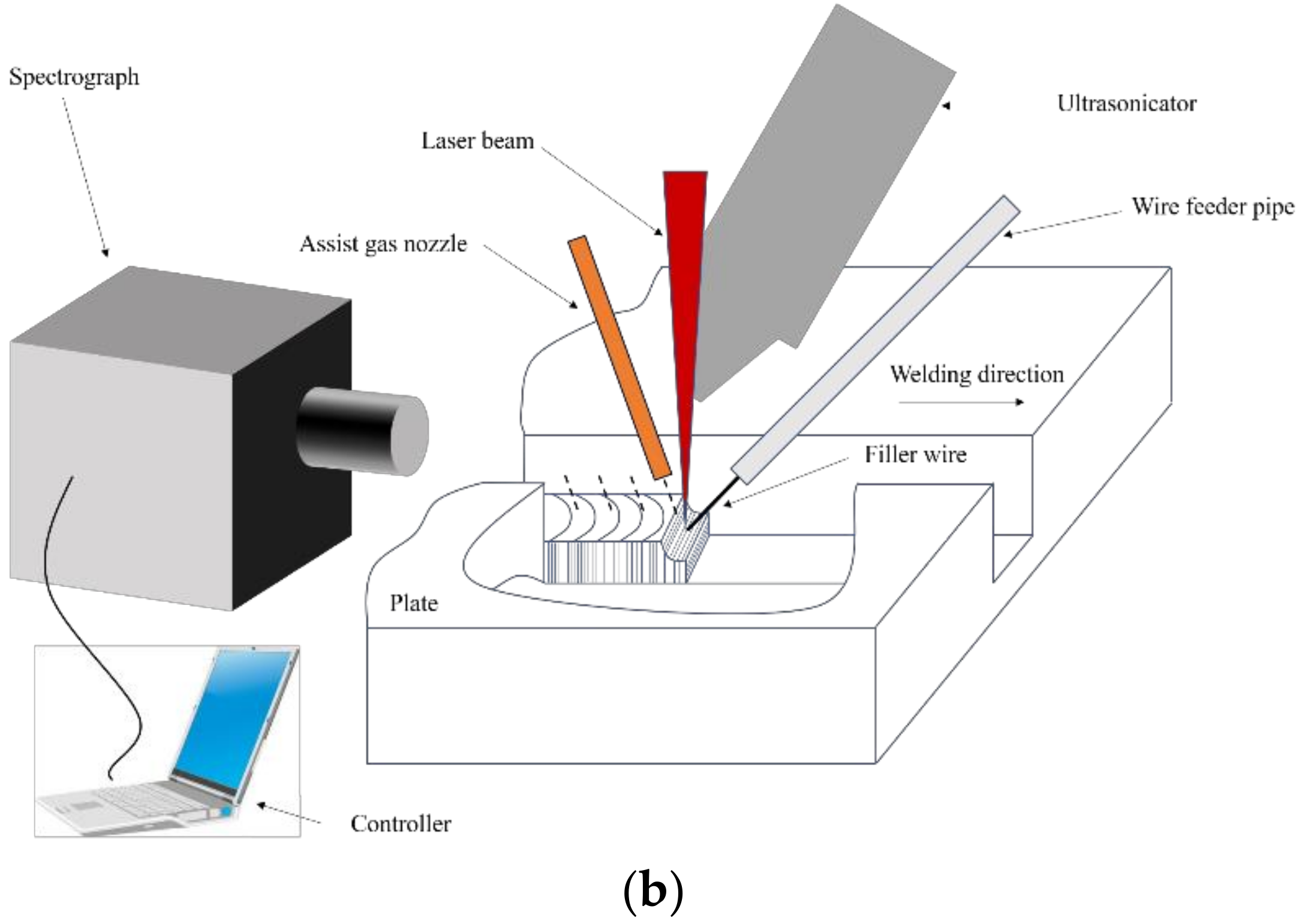

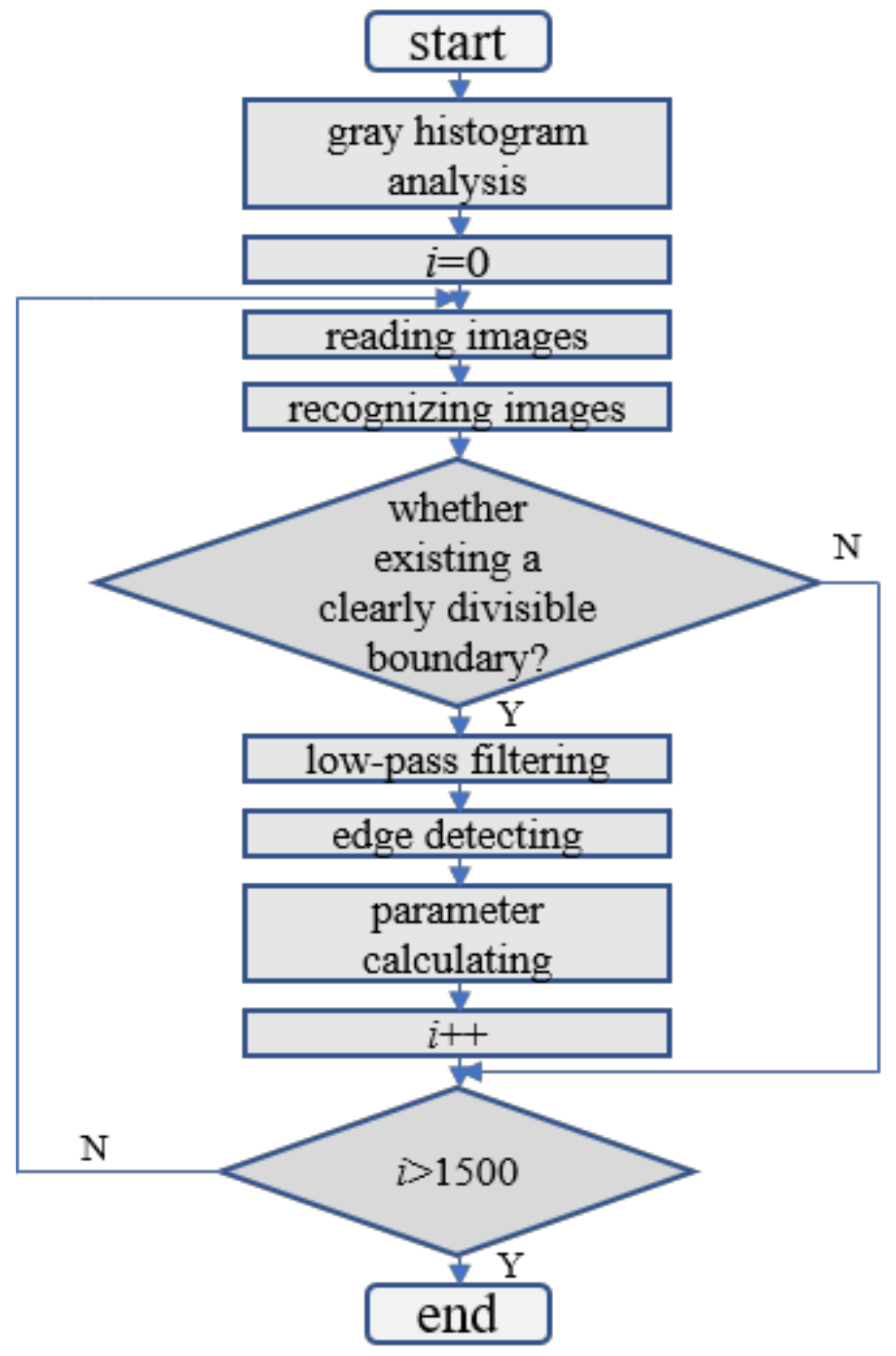
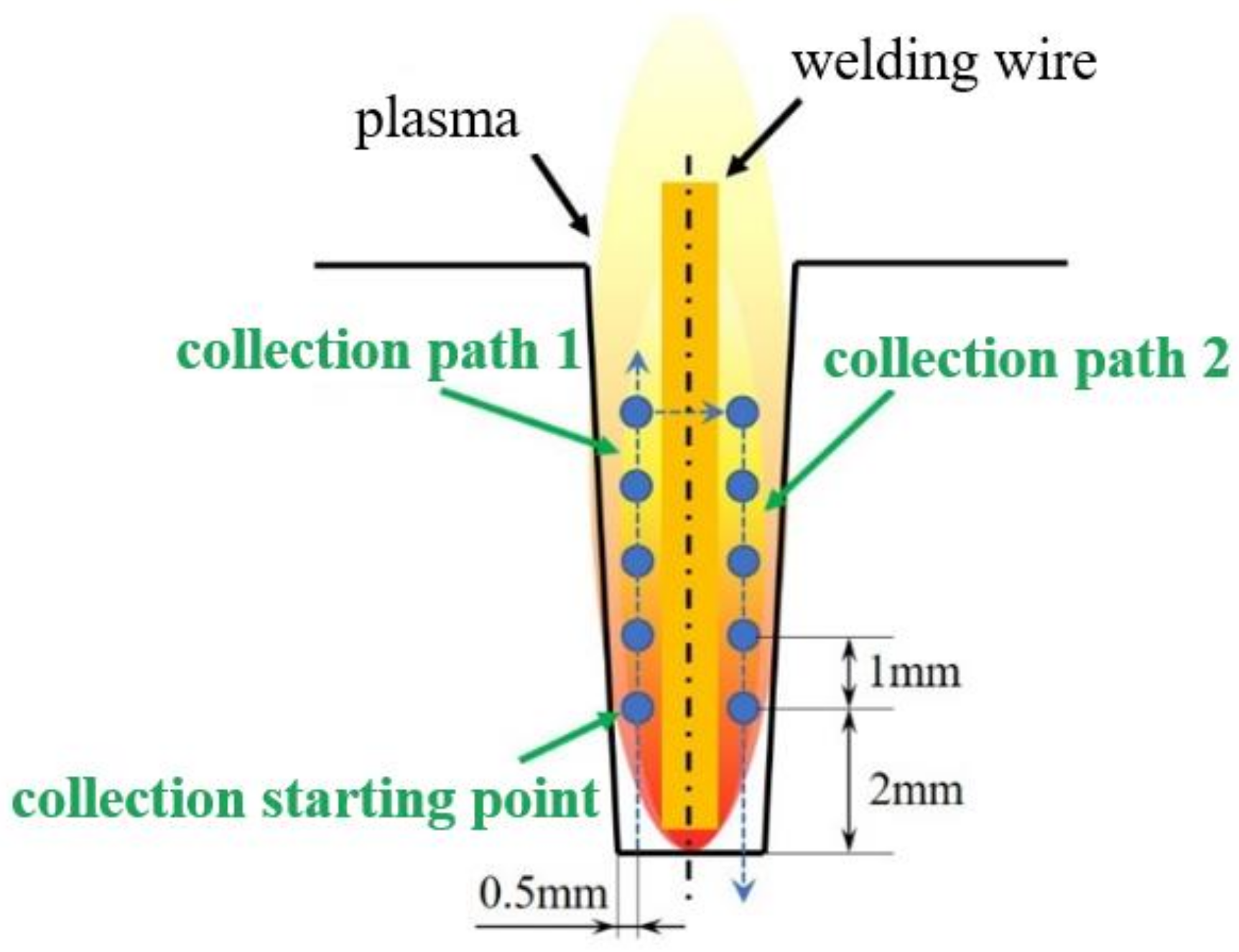

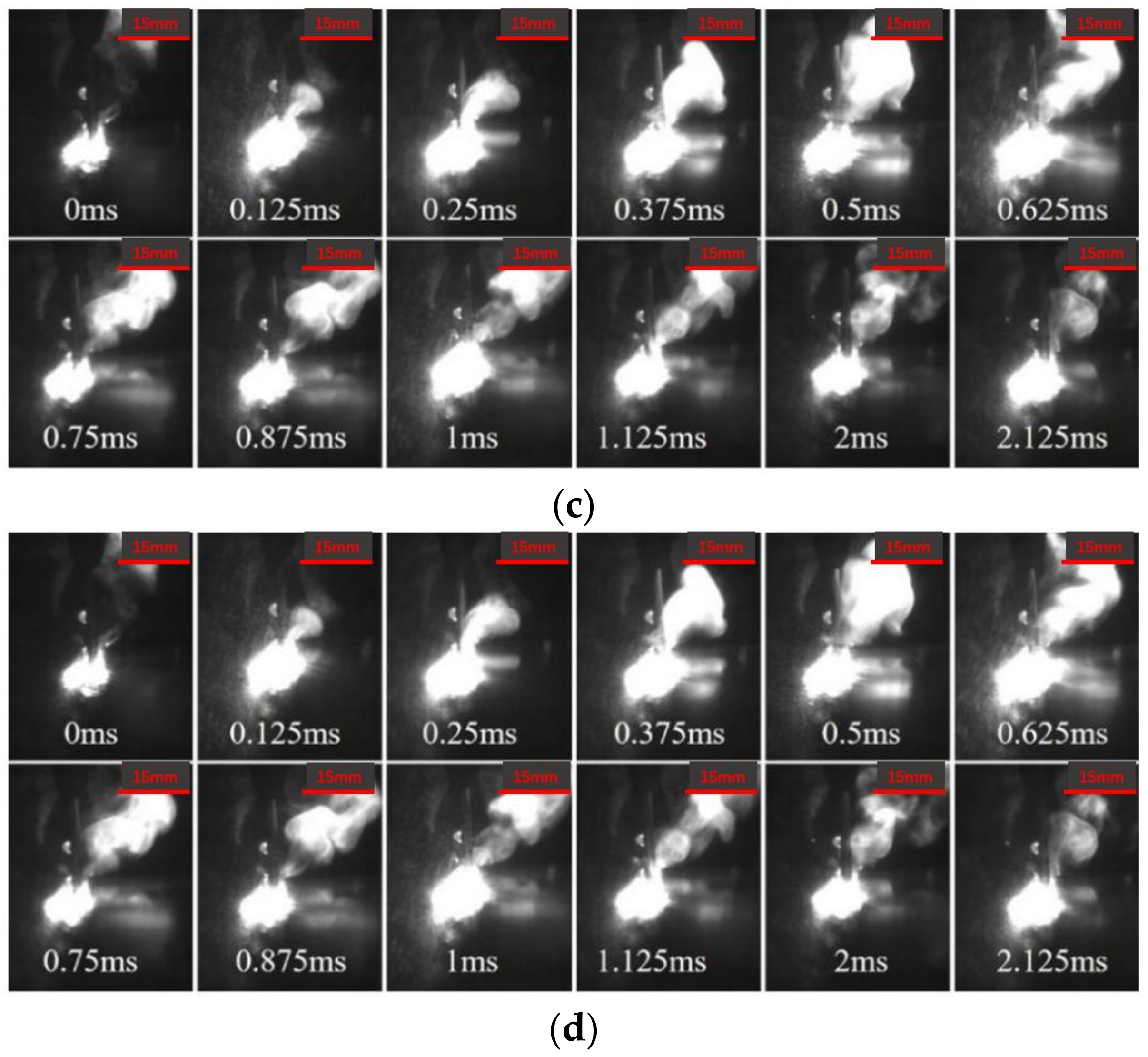

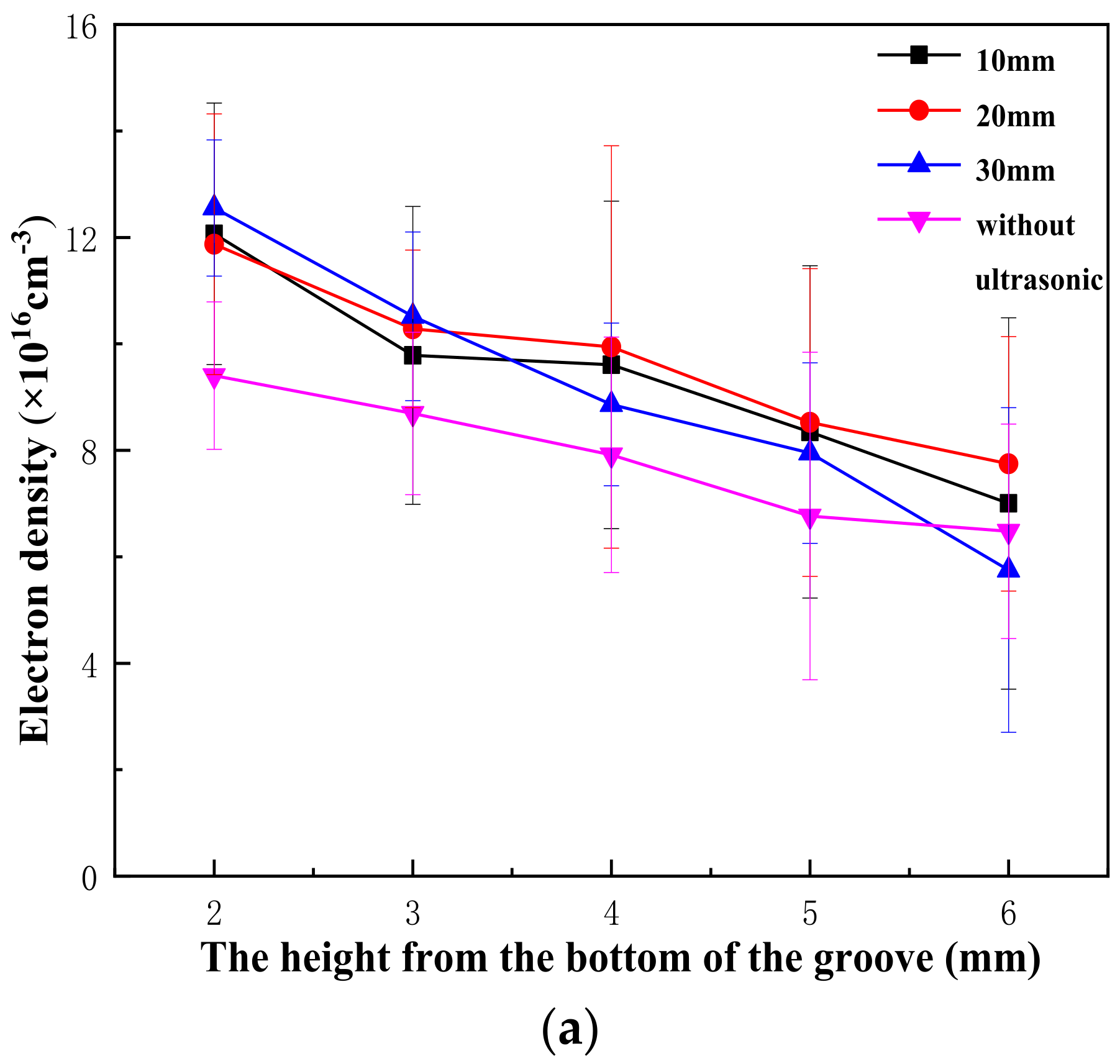

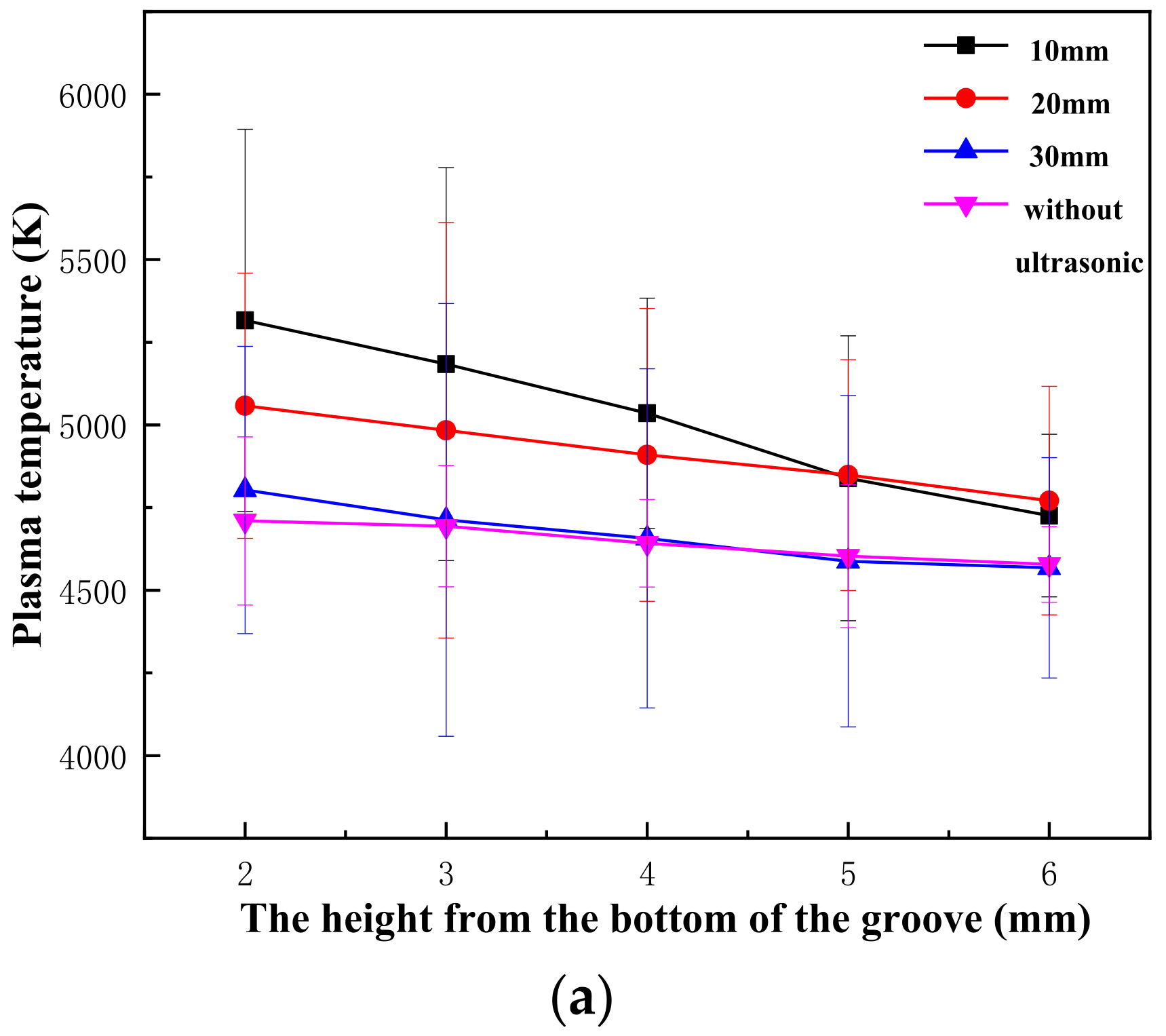

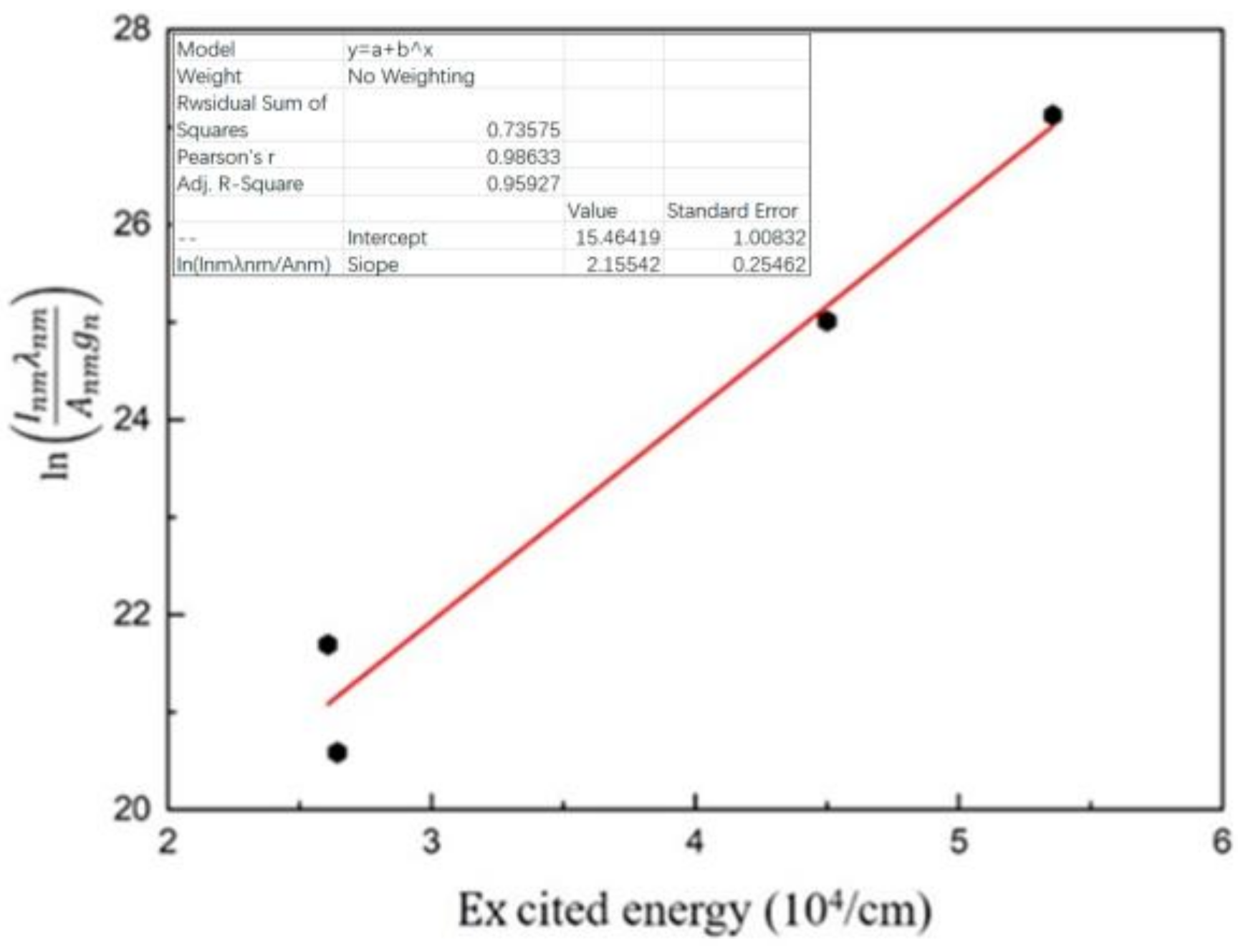
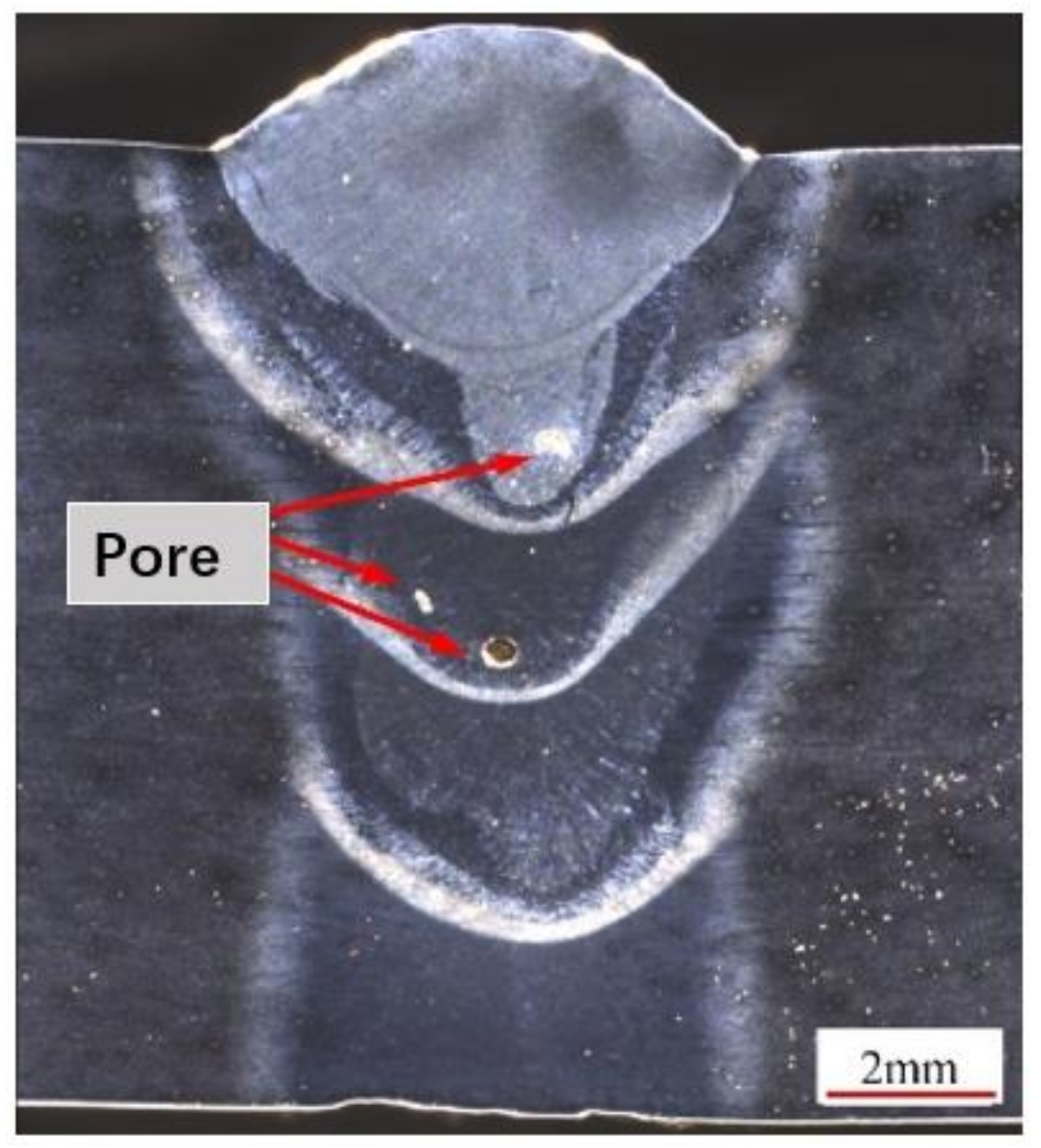
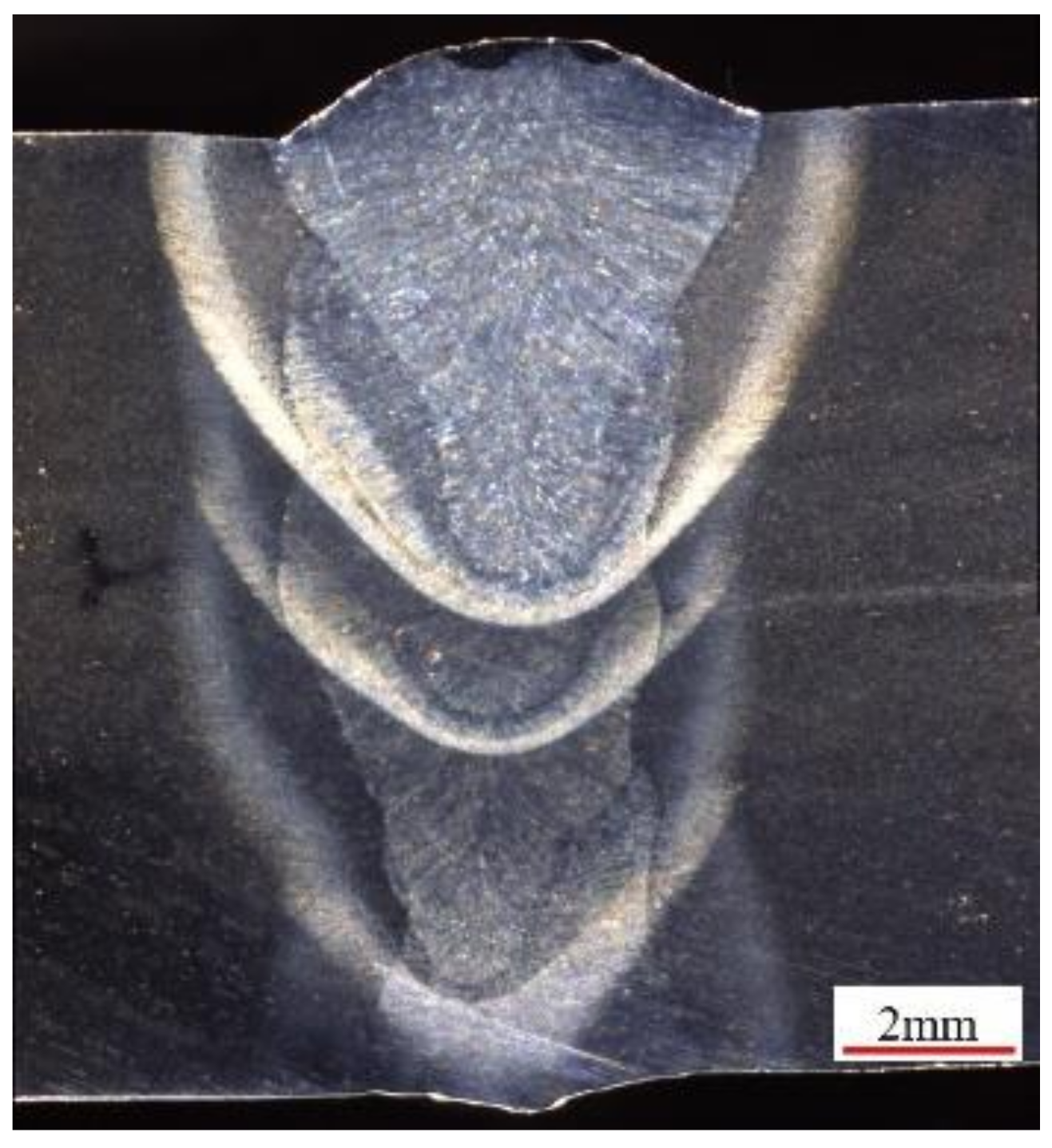
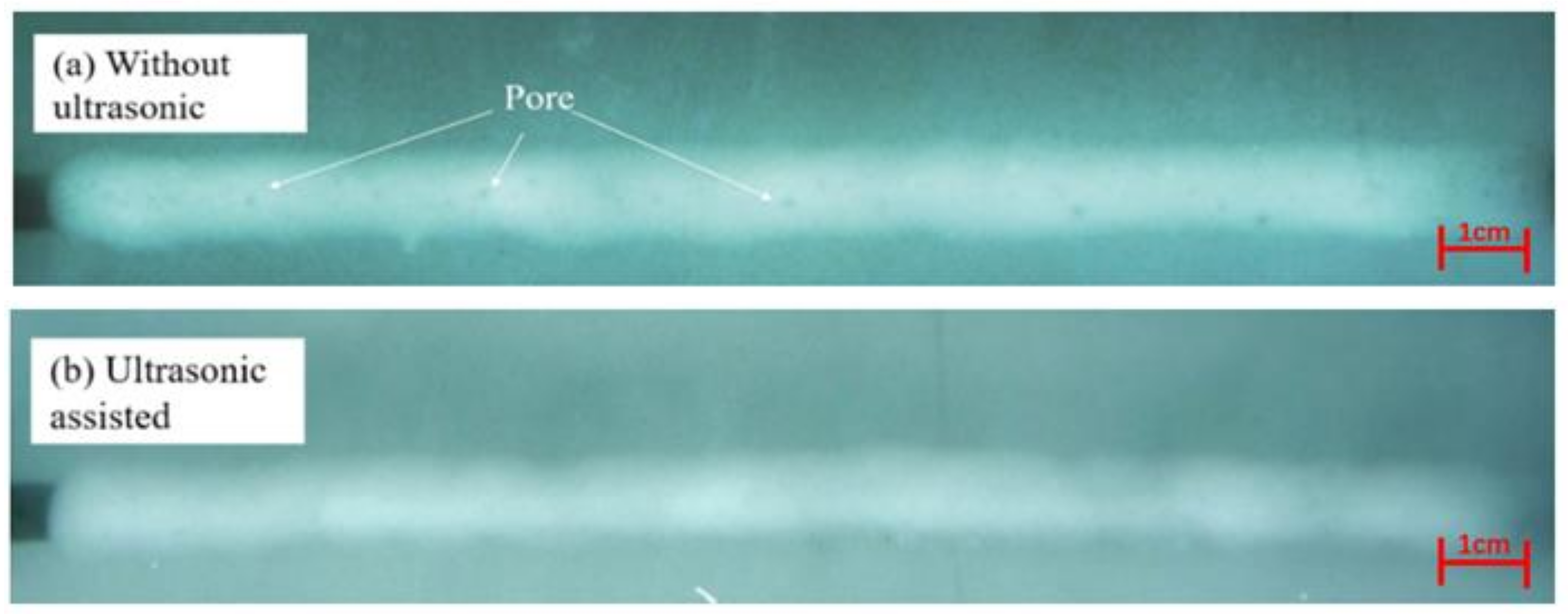

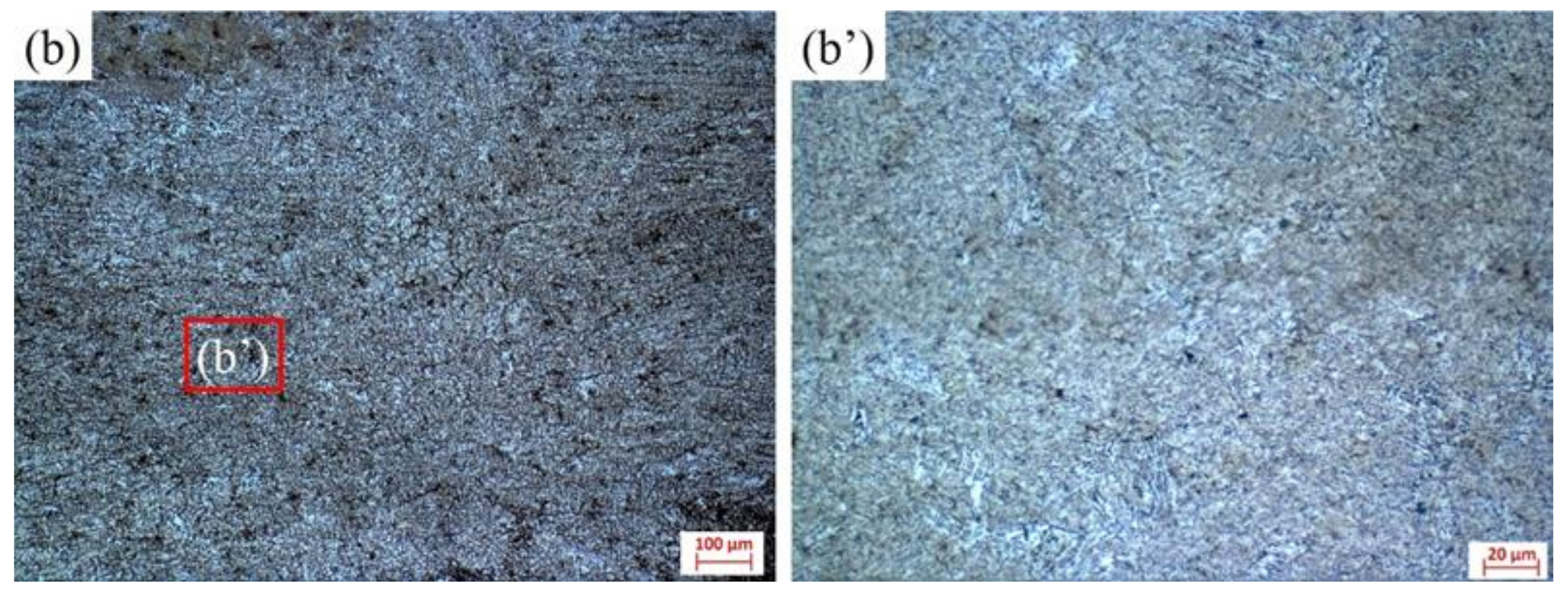
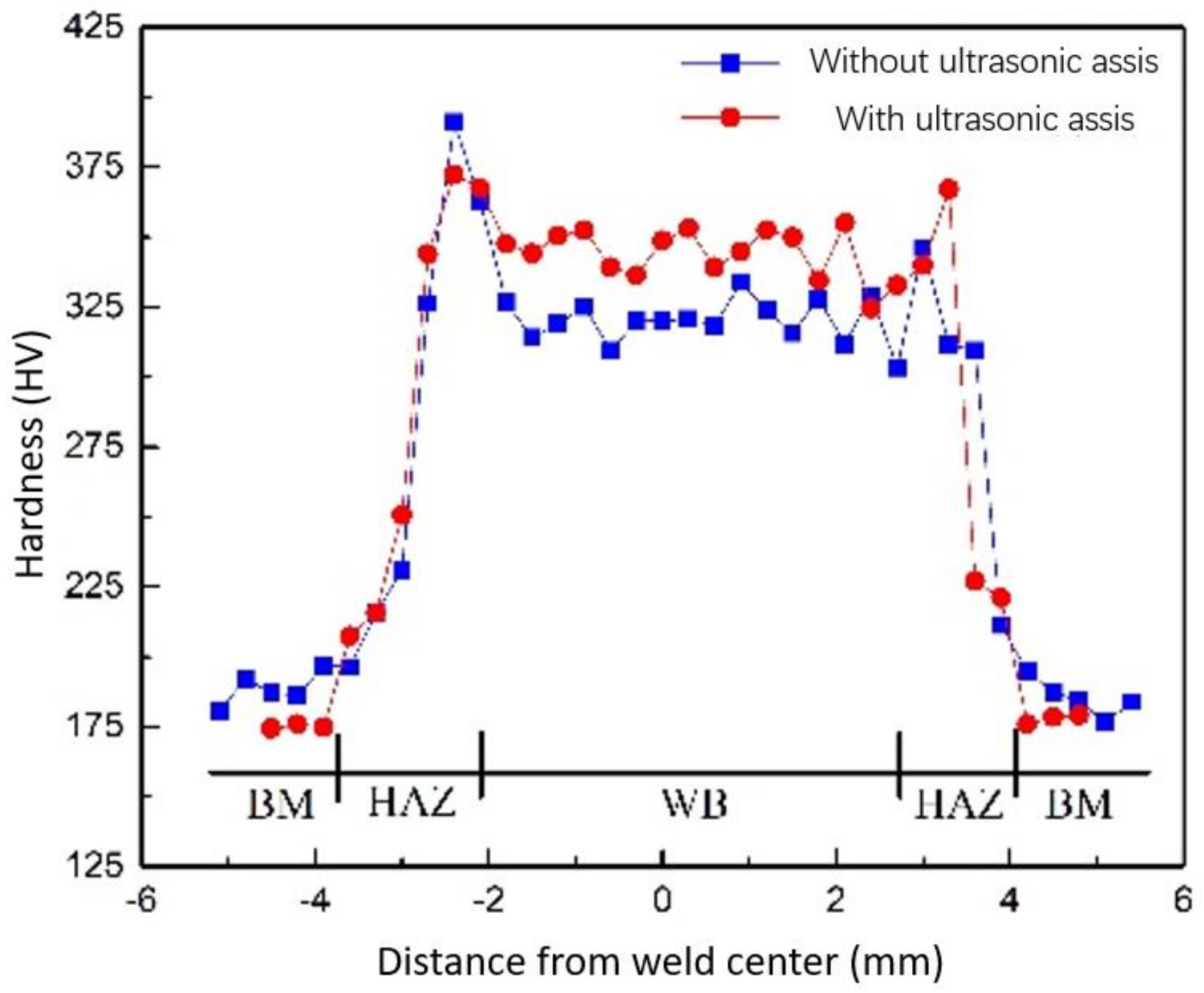
| Material | C | Mn | Si | P | S | Cu | V | Al |
|---|---|---|---|---|---|---|---|---|
| Q345D | ≤0.20 | ≤1.7 | ≤0.55 | ≤0.025 | ≤0.025 | ≤0.3 | 0.02–0.15 | ≥0.015 |
| ER50-6 | 0.06–0.15 | 1.4–1.85 | 0.80–1.15 | ≤0.025 | ≤0.035 | ≤0.5 |
| Wave Length (nm) | En (cm−1) | En (eV) | gn | Anm (108 s−1) |
|---|---|---|---|---|
| 537.149 | 26,339.696 | 3.2675 | 5 | 0.0105 |
| 538.337 | 53,352.989 | 6.6149 | 13 | 0.781 |
| 539.317 | 44,677.000 | 5.5392 | 9 | 0.0491 |
| 539.713 | 25,899.989 | 3.2112 | 9 | 0.00258 |
| Layer Number | Power (kW) | Welding Speed (m/min) | Wire Feeding Speed (m/min) | Defocus Length (mm) |
|---|---|---|---|---|
| 1 | 5.8 | 0.36 | 1.5 | +10 |
| 2–3 | 5.0 | 0.48 | 4.0 | +20 |
| 4 | 5.8 | 0.36 | 3.5 | +40 |
Disclaimer/Publisher’s Note: The statements, opinions and data contained in all publications are solely those of the individual author(s) and contributor(s) and not of MDPI and/or the editor(s). MDPI and/or the editor(s) disclaim responsibility for any injury to people or property resulting from any ideas, methods, instructions or products referred to in the content. |
© 2023 by the authors. Licensee MDPI, Basel, Switzerland. This article is an open access article distributed under the terms and conditions of the Creative Commons Attribution (CC BY) license (https://creativecommons.org/licenses/by/4.0/).
Share and Cite
Wang, R.; He, Z.; Kan, X.; Li, K.; Chen, F.; Fu, J.; Zhao, Y. Dynamic Characteristics of Plasma in Ultrasonic-Assisted Narrow-Gap Laser Welding with Filler Wire. Materials 2023, 16, 502. https://doi.org/10.3390/ma16020502
Wang R, He Z, Kan X, Li K, Chen F, Fu J, Zhao Y. Dynamic Characteristics of Plasma in Ultrasonic-Assisted Narrow-Gap Laser Welding with Filler Wire. Materials. 2023; 16(2):502. https://doi.org/10.3390/ma16020502
Chicago/Turabian StyleWang, Ren, Zhenxing He, Xiaoyang Kan, Ke Li, Fugang Chen, Juan Fu, and Yong Zhao. 2023. "Dynamic Characteristics of Plasma in Ultrasonic-Assisted Narrow-Gap Laser Welding with Filler Wire" Materials 16, no. 2: 502. https://doi.org/10.3390/ma16020502




